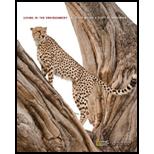
The concepts of this section. Analyze an environmentally sustainable society. The relation between natural income and sustainability describes the efforts of Tuy Suereivathana’s efforts to prevent the elephant’s extinction and the country’s poverty. Also, determine the two pieces of good news that are leading a transition to a more sustainable society and based on the three scientific principles of sustainability and the three social science principles of sustainability the three important ways to make a transition to sustainability as summarized in this chapter’s three big ideas. The explanation regarding the way in which the six principles of sustainability move us closer to the vision of a more sustainable world.
Want to see the full answer?
Check out a sample textbook solution
Chapter 1 Solutions
Living in the Environment
- I need help with part b and c. I don't want an explanation I need the actual graph, because it's hard to understand an explanation without showing what they mean.arrow_forwardI need help with part b and c. I don't want an explanation I need the actual graph preferably broken down, because it's hard to understand an explanation without showing what they mean.arrow_forwardI need help with part b and c I don't know how to draw it.arrow_forward
- 4. What is the geologic range of the fossil shown in Figure 10.15? From the Ordovician period through the Permian period. 5. What is the geologic range of the fossil shown in Figure 10.16? From the Cambrian period through the Permian period. 6. Imagine that you have discovered a rock outcrop that contains the fossils identified in Questions 4 and 5. What is the geologic range of this rock?From theperiod through the period.arrow_forward4. What is the geologic range of the fossil shown in Figure 10.15? From the period through the period5. What is the geologic range of the fossil shown in Figure 10.16? From the period through the period.arrow_forwardACTIVITY 10.6 Types of Fossils Pg 174 1. Refer to Figure 10.13. Which photo(s) (A-1) best illustrate(s) the methods of fossilization or fossil evidence listed below? (Photos/letters may be used more than once.)Permineralization: The small internal cavities and pores of an original organism that are filled with precipitated mineral matter. Photo(s):Cast: The space once occupied by a dissolved shell or other structure that is subsequently filled with mineral matter. Photo(s):Carbonization: Preservation that occurs when fine sediment encases delicate plant or animal forms and leaves a residue of carbon, Photo(s):Impression: A replica of an organism, such as a leaf, left in fine-grained sedimentary rock. Photo(s):Amber: Hardened resin of ancient trees that preserved delicate organisms such as insects. Photo(s):Indirect evidence: Traces of prehistoric life but not the organism itself. Photo(s):arrow_forward
- ACTIVITY 10.7 Fossils as Time Indicators Pgs 175-176Use Figure 10.14, page 175, to complete the following. 1. What is the geologic range of plants that belong to the group Ginkgo?From theperiod through theperiod. 2. What is the geologic range of Lepidodendron, an extinct coal-producing plant?From theperiod through theperiod. 3. Imagine that you have discovered an outcrop of sedimentary rock that contains fossil shark teeth and fossils of Archimedes. In which time periods might this rock have formed?From theperiod through theperiod.arrow_forwardACTIVITY 10.4 Unconformities Pg 1721. Label the angular unconformity and disconformity on Figure 10.10. 2. Identify the types of unconformities in Figure 10.11A and Figure 10.11Barrow_forwardACTIVITY 10.3 Principles of Cross-Cutting and Inclusions Pg 171Figure 10.8 is a geologic cross-section of a hypothetical area. Use it to answer the following questions. 1. Is the igneous intrusion, dike E, older or younger than rock layers A-D? 2. Is fault H older or younger than rock layers A-D? 3. Is fault H older or younger than sedimentary layers F and G? 4. Did fault H occur before or after dike E? Explain how you arrived at your answer. 5. What evidence supports the conclusion that the igneous intrusion labeled sili B is more recent than the rock layers on either side (A and C)? ACTIVITY 10.5 Applying Relative Dating Principles Pg 173Use Figure 10.12 to complete the following. 1. Identify and label the unconformities in Figure 10.12. 2. Is rock layer I older or younger than layer H? What relative dating principle did you apply to determine your answer?Rock layer I isthan layer H.Relative dating principle: 3. Is fault L older or younger than rock layer D? What principle did you…arrow_forward
 Applications and Investigations in Earth Science ...Earth ScienceISBN:9780134746241Author:Edward J. Tarbuck, Frederick K. Lutgens, Dennis G. TasaPublisher:PEARSON
Applications and Investigations in Earth Science ...Earth ScienceISBN:9780134746241Author:Edward J. Tarbuck, Frederick K. Lutgens, Dennis G. TasaPublisher:PEARSON Exercises for Weather & Climate (9th Edition)Earth ScienceISBN:9780134041360Author:Greg CarbonePublisher:PEARSON
Exercises for Weather & Climate (9th Edition)Earth ScienceISBN:9780134041360Author:Greg CarbonePublisher:PEARSON Environmental ScienceEarth ScienceISBN:9781260153125Author:William P Cunningham Prof., Mary Ann Cunningham ProfessorPublisher:McGraw-Hill Education
Environmental ScienceEarth ScienceISBN:9781260153125Author:William P Cunningham Prof., Mary Ann Cunningham ProfessorPublisher:McGraw-Hill Education Earth Science (15th Edition)Earth ScienceISBN:9780134543536Author:Edward J. Tarbuck, Frederick K. Lutgens, Dennis G. TasaPublisher:PEARSON
Earth Science (15th Edition)Earth ScienceISBN:9780134543536Author:Edward J. Tarbuck, Frederick K. Lutgens, Dennis G. TasaPublisher:PEARSON Environmental Science (MindTap Course List)Earth ScienceISBN:9781337569613Author:G. Tyler Miller, Scott SpoolmanPublisher:Cengage Learning
Environmental Science (MindTap Course List)Earth ScienceISBN:9781337569613Author:G. Tyler Miller, Scott SpoolmanPublisher:Cengage Learning Physical GeologyEarth ScienceISBN:9781259916823Author:Plummer, Charles C., CARLSON, Diane H., Hammersley, LisaPublisher:Mcgraw-hill Education,
Physical GeologyEarth ScienceISBN:9781259916823Author:Plummer, Charles C., CARLSON, Diane H., Hammersley, LisaPublisher:Mcgraw-hill Education,





